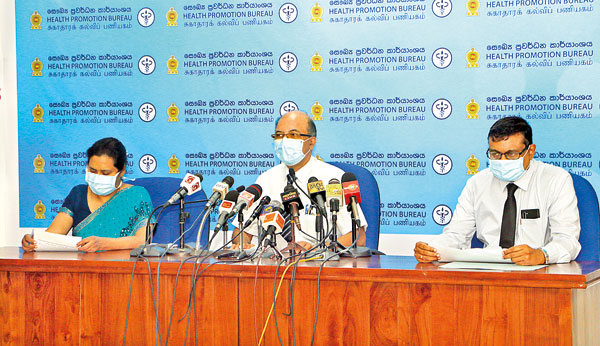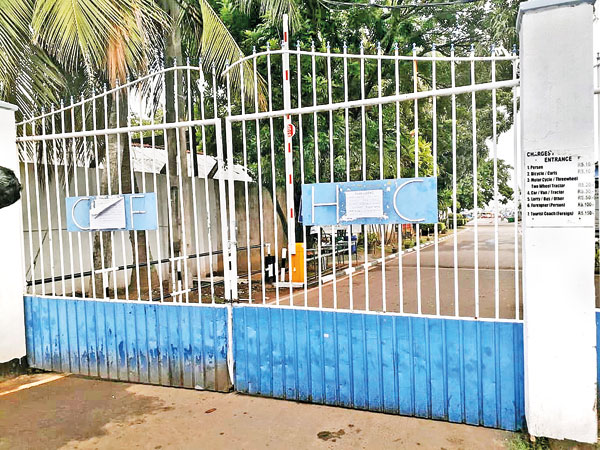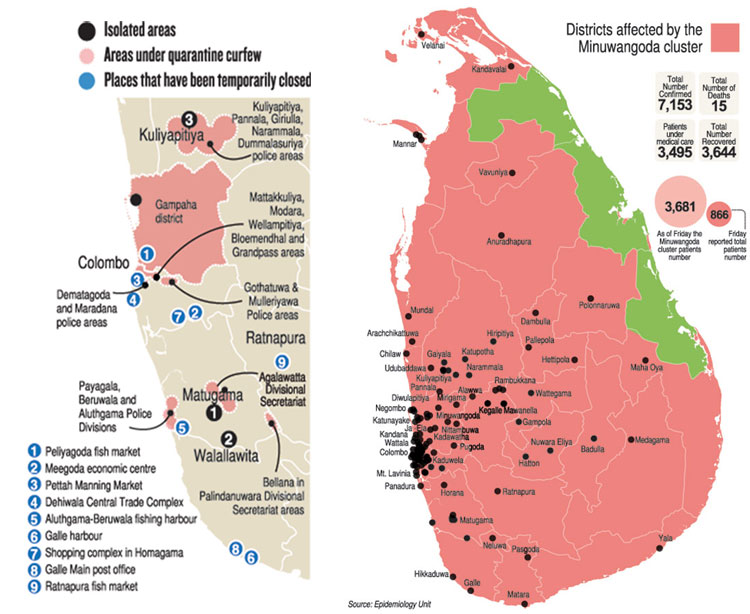News
COVID-19 situ not uncontrollable, but plea for public support

Corona media briefing: From left are Dr. Inoka Suraweera, Dr. Hemantha Herath and Dr. Palitha Karunapema. Pic by Priyanka Samaraweera
The situation is not uncontrollable but we need the strong support of the public to curb the rapid spread of COVID-19.
This was the assurance and urgent plea by a top-level Health Ministry official both at a face-to-face interview with the Sunday Times on Thursday and a media conference on Friday.
As of Saturday afternoon, two deaths were linked to the latest Minuwangoda cluster which came to light on October 4, leaving a trail of illness among 3,681. The dead were a 50-year-old woman from Kuliyapitiya who succumbed to COVID-19 at the National Institute of Infectious Diseases (NIID), Angoda, and a 56-year-old man also from Kuliyapitiya who succumbed in the area’s hospital.
The Peliyagoda fish market cluster apparently related to the Minuwangoda cluster has hit 791 cases, as at last afternoon.
More areas and organisations fell like dominoes to COVID-19 including a few five-star hotels in Colombo.

The closed Beruwala fish market. Pic by Thusitha Kumara
“There has been an increase in the number and geographical regions affected by COVID-19. Though the situation has become barapathala (grave), it is not uncontrollable, but we need the unstinting support of the people,” said the Deputy Director-General (DDG-Public Health Services I), Dr. Hemantha Herath.
He urged that people listen and abide by the preventive and control measures set out by the health staff which includes constant hand-washing or using sanitizer; wearing a face-mask properly at all times in public places; keeping a metre distance in public places; following respiratory etiquette (sneezing and coughing into the crook of the arm); and not travelling around unless essential.
When asked during the interview about the current situation, he told the Sunday Times that based on the information that they get from the field there is no way to say that community spread has begun in Sri Lanka. Cases are reported from different parts of the country but what is really happening is that initially they do not seem to be linked to any other persons, but once you get the details of those patients, within two three days you find that they are connected to the Minuwangoda cluster.
“There are one or two cases in which we have not established a real connection to the main cluster, but out of them also, from time to time, you will find there is a connection – a middle person in-between two connections being the cause of infection. Therefore, epidemiologically speaking, we are not in a position to declare that this is a community spread. However, we have to take the same precautions,” he said, reiterating that he tells the public: “Don’t worry whether this is community spread or not, take your precautions.”
The source too of the Minuwangoda cluster has not been found yet, the Sunday Times learns.
“It is extremely difficult to isolate the first case without identifying the source, as there are a thousand people to check,” said Dr. Herath.
The Sunday Times learns that Health Ministry officials including Secretary, Major-General Dr. Sanjeewa Munasinghe and Acting Director-General of Health Services, Dr. S. Sridharan, meet daily at 8.30 a.m. to analyse the situation and rectify any gaps or problems.
“Then we plan for the next day or not exactly just the day but at least for three to four days because the situation is fluid and we can’t plan for two, three weeks,” said Dr. Herath.
The thinking behind quarantine curfews
DDG Dr. Herath explained that quarantine curfews are being clamped in some areas after considering whether those areas are dynamic, with regard to the spread of COVID-19. Are a large number of people moving in and out of an area, is considered as then the public health measures may not work. Another reason is when the cooperation of the public is not sufficient to achieve the objectives of these public health intervention.
Quarantine curfew is a basic containment measure if the number of people who are affected is high and the rate of emerging cases is also high, he said, taking as a case in point the Peliyagoda fish market which sees a large number of people coming and going in and out.

| Mapping industries Reiterating that the managements of factories have a “huge” responsibility, Dr. Inoka Suraweera, Consultant Community Physician of the Health Ministry’s Environmental and Occupational Health Unit, told Friday’s media briefing that as far back as March-April factories were instructed to appoint focal points to ensure the safety of workers. “We had requested all the information about factory workers (name, temporary & permanent addresses, contact number etc) but there are some gaps. As such we have held discussions with Board of Investment (BOI) zonal managers to expedite the collection of such data,” she said, pointing out that the Medical Officers of Health (MOH) and Public Health Inspectors (PHIs) are in the process of making comprehensive map of the industries in their areas. The deadline for receiving this data from industries, categorized into two – large-scale (with more than 250 employees) and medium-scale (between 250 and 50 employees) – has been set for October 31, it is learnt. If a factory is in an Export Promotion Zone, these data should also be sent to that office. Underscoring that factory workers contribute a lot to the economy, Dr. Suraweera said that they need to be kept safe. “We have clearly instructed that any worker who is ill should not be made to work. If there are any with COVID-19 like symptoms, their details should be recorded and the area’s MOH informed.
| |
| If suspected of being exposed to a positive case, here’s what you can doIf you suspect that you have been exposed to someone who is COVID-19 positive in any of the clusters (Minuwangoda and Peliyagoda), this is what you may do.You may call the Public Health Inspector (PHI) or the Medical Officer of Health (MOH) and seek his/her advice. PHIs may be accessed through: www.phi.lkWho decides who should take an RT-PCR test?“An RT-PCR test should be taken under medical guidance and nobody should be allowed to do the RT-PCR test without a doctor’s referral, said Deputy Director-General (Public Health Services I), Dr. Hemantha Herath, pointing out that if someone goes to a doctor seeking this test, the doctor would carry out a risk assessment according to the guidelines given by the Health Ministry available on the website of the Epidemiology Unit. He said that it is only with this referral letter that an RT-PCR test should be sought. Thereafter, whatever designated laboratory that does the test, after ensuring that there is a doctor’s referral, would have to convey the result to the Epidemiology Unit, especially if it is ‘positive’. The result should be communicated along with information such as the tested person’s name, age, date of test, address and contact details. Then the Epidemiology Unit would act on a ‘positive’ result and the patient would be hospitalised and his/her first second level contacts traced. With regard to quarantining of contacts, Dr. Herath said that they agree that quarantining all individuals in state quarantine centres cannot go on in this manner. “We have now instituted that health professionals should do a proper risk assessment and based on that decide whether to do a RT-PCR test today, tomorrow or some other day or not do a test at all. A decision could also be made whether the person needs to be quarantined at an institutional quarantine centre or at home. That will be made as an informed decision after a proper risk assessment by a trained health staff member. We have already gone to that level,” he said. He added that this is why people need to adhere strictly to self-quarantine or home quarantine and support the health staff. It is their responsibility, as it is impossible to put a sentry at every household.
| |
| Suggestions from Prof. Malik PeirisWell-known virologist Prof. Malik Peiris based in Hong Kong but currently in Sri Llanka made an in-depth presentation to senior Health Ministry officials on Monday, the Sunday Timeslearns.“Prof. Peiris recommended certain things on how to detect a patient, what would be the appropriate method to diagnose a patient and also what would be the appropriate method to do disease surveillance,” said Deputy Director-General (Public Health Service I), Dr. Hemantha Herath, explaining that clinicians, virologists and other health experts are studying these suggestions.The Sunday Timesunderstands that Prof. Peiris’s suggestions covered appropriate tests for screening and diagnosis, with a re-look at the criteria on whom RT-PCR testing, the gold standard, should be performed so that resources are saved for urgent needs. He had also suggested other lines or alternative testing methods such as antigen and antibody depending on the circumstances.The discussions had also centred on when to discharge patients from hospital and those in quarantine, what kind of community sampling should be done, etc. Hospitals & testing There are 26 COVID-19 treatment hospitals and 24 centres performing RT-PCR testing, Health Promotion Bureau Director Dr. Palitha Karunapema told Friday’s media briefing. He read out a statement from the Medical Director of the Castle Street Hospital, Dr. P.B. Pradeep Wijeysinghe assuring that this premier hospital is safe and women should not hesitate to come there. He had explained that on October 6, there was a COVID-19 suspected case identified (a mother). When it was confirmed that she was COVID-19 positive, she had been transferred to the Mulleriyawa Hospital. Following this, social media had comments that the hospital was not safe. Rejecting these allegations, Dr. Wijeysinghe assured that there are no issues at the hospital and it was safe to seek treatment there. With regard to hospital beds across the country, other sources told the Sunday Times that more than 50,000 beds along with 600 ICU beds are available in state hospitals. As of Wednesday, in the hospitals designated for the treatment of COVID-19, of the 2,676 beds available, 2,498 were occupied, while only a few of the 150 ICU beds earmarked for critically-ill COVID-19 patients were occupied. Meanwhile, 24 laboratories (the MRI, hospitals and universities) are conducting RT-PCR testing and on Wednesday more than 8,000 tests had been done, it is learnt.
| |
| New system at BIA & MRIABoth the Bandaranaike International Airport (BIA), Katunayake and the Mattala Rajapaksa International Airport (MRIA) are following a new system with new restrictions, said Airport and Aviation Services Limited (AASL) Chairman, Major-General (Retd.) G.A. Chandrasiri.According to him only 1/3rd of the staff is reporting to work and all staff members are being subjected to compulsory RT-PCR tests, with around 150 samples being collected each day. This is while other departments such as customs and immigration have their own systems. Staff members from areas where curfew has been imposed are not reporting to duty.Meanwhile, Mr. Chandrasiri said that repatriation flights have been suspended temporarily. However, about 12 charter flights and 12 cargo flights arrive each day at the BIA and all protocols such as testing and quarantining are carried out. There are also transit flights, while departure flights too take-off from here. Flight operations at the MRIA have decreased and there is only one flight arriving per day on average.He said that the first day the Minuwangoda cluster was identified, a female employee of the janitorial service which is outsourced tested positive. The same night, 187 more underwent testing and 42 people who were contacts of this patient were isolated. The next day, another male, also from an outsourced service tested positive. They are both receiving treatment at the NIID. Around 300-400 people are working in the cargo division and on Wednesday 117 tests were performed, all of which came out negative.With regard to flight crews, Mr. Chandrasiri said that previously SriLankan Airline members went into home quarantine but now foreign airline and SriLankan airline crew are being quarantined at a designated hotel quarantine centre (Hotel Mandarin or Airport Garden Hotel), followed by another 14 days of home quarantine. In case their flight is scheduled to leave before quarantine is concluded, they are allowed to do so. Flight crews are tested on arrival and after five days and seven days, he added.
| |
| Different clusters being probedCOVID-19 positive cases are being reported from the Katunayake, Peliyagoda fish market, Horana and Kuliyapitiya clusters, while Minuwangoda and Divulapitiya clusters are going down, said the President of the Public Health Inspectors’ (PHIs) Union, Upul Rohana.He stressed that the Peliyagoda fish market cluster is the most dangerous as this might have spread to the fishermen in other areas as well. This is how COVID-19 has hit Beruwala and Dikowitta. The people who visited these markets may have been exposed to the virus.Looking at the clusters, Mr. Rohana said that the Kuliyapitiya infection has been there since September 28. There was a ‘deva mehaya’ on the same day and a bride- groom who attended it tested positive on October 2, similar to the patient who tested positive at the Gampaha Hospital. So no source has been found for both the groups in Minuwangoda and Kuliyapitiya.”Sometime back, a COVID-19 patient from Peliyagoda ran away from the Ragama Hospital. When we found him he was with another person who was a drug addict. We did not have an ambulance to take the patient and had to wait for six hours. Somehow the other man ran away,” he said, adding that the virus might have leaked to Peliyagoda during this time.Reiterating that “nothing is confirmed”, he said that investigations are still going on. | |

